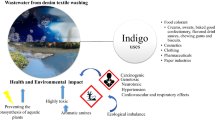Abstract
Astrazon red azodye that is still widely used in Turkey is released into the aquatic environment. Since these dyes are degradable into the toxic aromatic amines, they have become a public health and environmental concern. In this study, the biosorption of the Astrazon red dye from aqueous solutions on dehydrated cells of Rhodopseudomonas sp. 51ATA was studied as a function of each pH, temperature and initial dye concentration. Rhodopseudomons sp. 51ATA strain belongs to the Rhodopseudomonas species which is an eco-friendly photosynthetic and facultative anaerobic bacterium. The best uptake of Astrazon red was observed at pH 2.0 and the data obtained were applied to both Freundlich and Langmuir adsorption isotherms. The adsorption data provided an excellent fit to both isotherms and showed good agreement to Scatchard analysis at various temperatures. Freundlich isotherm showed good fit to the data at low temperatures while Langmuir model was suitable for describing the adsorption at higher temperatures. Therefore, from these data, we could report that Rhodopseudomonas sp. 51ATA strain is very efficient bacterium for the removal of dyes from wastewater.







Similar content being viewed by others
References
Aksu Z (2005) Application of biosorption for the removal of organic pollutants. Process Biochem 40:997–1026
Çelik L, Öztürk A, Abdullah MI (2012) Biodegradation of reactive red 195 azo dye by the bacterium Rhodopseudomonas palustris 51ATA. Afr J Microbiol Res 6(1):120–126
Dumrul H, Kurşunlu AN, Güler E et al (2011) Adsorptive removal of Cu(II) and Ni(II) ions from aqueous media by chemical immobilization of three different aldehydes. Desalination 1(3):92–93
Erciyes N, Gürten AA, Abdullah MI, Ayar A (2004) Adsorption of indole and 2-Methylindole on ligand-exchange matrix. J Colloid Interface Sci 278:91–95
Forgacs E, Cserhati T, Oros G (2004) Removal of synthetic dyes from wastewaters. Environ Int 30(7):953–971
Gaber M, Ghalwa NA, Khedr AM, Salem MF (2013) Electrochemical degradation of reactive yellow 160 dye in real wastewater using C/PbO2-, Pb+Sn/PbO2 + SnO2-and Pb/PbO2 modified electrodes. J Chem. https://doi.org/10.1155/2013/691763
Gadd GM (2009) Biosorption: critical review of scientific rationale, environmental importance and significance for pollution treatment. Chem Technol Biotechnol 84:13–28
Gürten AA, Uçan M, Özler MA, Ayar A (2005) Removal of aniline from aqueous solution by PVC-CDAE ligand-exchanger. J Hazard Mater B 120:81–87
Kot-Wasik A, Dąbrowska D, Namiesnik J (2004) The importance of degradation in the fate of selected organic compounds in the environment. Part I Gen Consider Polish J Environ Stud 13(6):607–616
Küçükosmanoğlu M, Gezici O, Ayar A (2006) The adsorption behaviours of methylene blue and methyl orange in a diaminoethanesporopollenin-mediated column system. Sep Purif Technol 52:280–287
Liu G, Zhou JT, Wang J, Song ZY, Qv YY (2006) Bacterial decolorization of azo dyes by Rhodopseudomonas palustris. World J Microbiol Biotechnol 22:1069–1074
Merugu R, Pratap Rudra MP, Badgu N, Girisham S, Reddy SM (2012) Factors influencing the production of hydrogen by the purple non-sulphur phototrophic bacterium Rhodopseudomonas acidophila KU001. Microb Biotechnol 5(6):674–678
Pfennig N (1969) Rhodopseudomonas acidophila sp a new species of the budding purple on-sulfur bacteria. J Bacteriol 99(2):597–602
Saratale RG, Saratale GD, Chang JS, Govindwar SP (2011) Bacterial decolorization and degradation of azo dyes. J Taiwan Instit Chem Eng 42:138–157
Selimoğlu H, Öztürk A, Arısoy M, Abdullah MI (2011) Biosorption of dichlorvous by the anaerobic photosynthetic bacterium Rhodopseudomonas palustris NU51. Fresenius Environ Bull 20(5):1183–1189
Srinivasan A, Viraraghavan T (2010) Decolourization of dye wastewaters by biosorbents. J Environ Manage 91:1915–1929
Vrati S, Verma J (1983) Production of molecular hydrogen and single cell protein by Rhodopseudomonas capsulata from cow dung. J Ferment Technol 61(2):157–162
Volesky B (2003) Sorption and biosorption. ISBN: 0973298308, 9780973298307, 316, BV Sorbex
Yoo ES, Libra J, Adrian L (2001) Mechanism of decolourization of azo dyes in an anaerobic mixed culture. J Environ Eng 127:844–849
Wang X, Cheng X, Sun D, Qi H (2008) Biodecolorization and partial mineralization of reactive black 5 by a strain of Rhodopseudomonas palustris. J Environ Sci 20:1218–1225
Wolfaardt GM, Lawrence JR, Robarts RD, Caldwell DE (1995) Bio-accumulation of the herbicide diclofop in extra cellular polymer and its utilization by a bio-film community during starvation. Appl Environ Microbiol 58:1110–1114
Xie GJ, Liu BF, Wang RQ, Ding J, Ren HY, Zhou X, Ren NQ (2015) Bio aggregate of photo-fermentative bacteria for enhancing continuous hydrogen production in a sequencing batch photo bioreactor. Sci Rep 5:16174
Acknowledgements
This work was supported by the Niğde Ömer Halisdemir University Research Fund (FEB 2013/13 BAP).
Author information
Authors and Affiliations
Corresponding author
Additional information
Publisher's Note
Springer Nature remains neutral with regard to jurisdictional claims in published maps and institutional affiliations.
This article is a part of the Topical collection in Environmental Earth Sciences on “Water Problems in E. Mediterranean Countries” guest edited by H. Gökçekuş, D. Orhon, V. Nourania, and S. Sozen.
Rights and permissions
About this article
Cite this article
Abdullah, M.I., Öztürk, A. & Bayol, E. Biosorption of astrazon red dye by the bacterium Rhodopseudomonas sp. strain 51ATA. Environ Earth Sci 80, 49 (2021). https://doi.org/10.1007/s12665-020-09314-7
Received:
Accepted:
Published:
DOI: https://doi.org/10.1007/s12665-020-09314-7




